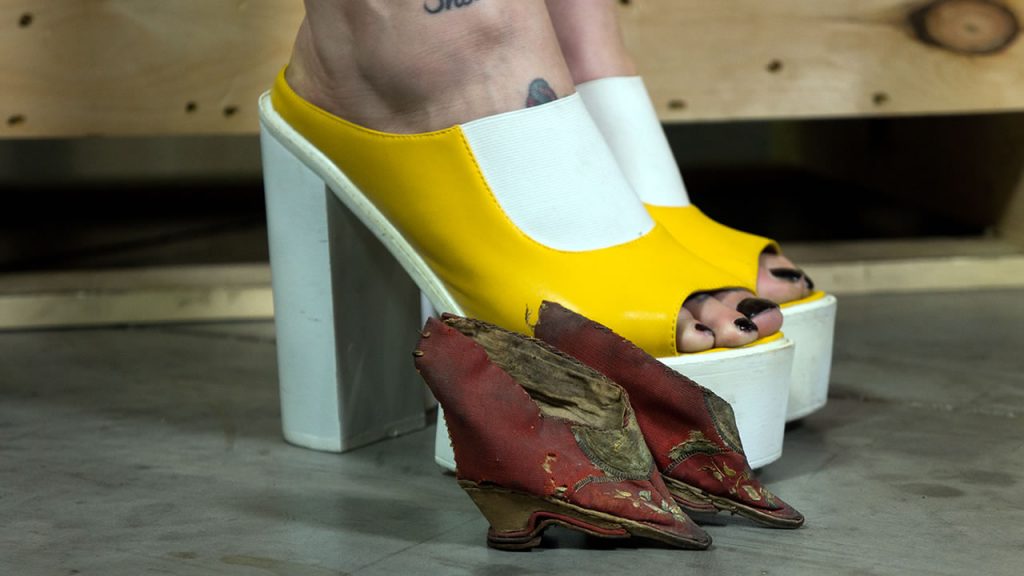Winner of the Fall 2016 StMU History Media Award for
Best Use of Scholarship
Best Article in the Category of “World History”
Best Use of Primary Sources
When I knew I couldn’t suffer another moment of pain and tears fell on my bloody bindings, my mother spoke softly into my ear, encouraging me to go one more hour, one more day, one more week, reminding me of the rewards I would have if I carried on a little longer. In this way, she taught me how to endure—not just the physical trials of footbinding or childbearing, but the more torturous pain of the heart, mind, and soul.1
More often than necessary, women are consumed with the idea of infatuation. Every culture has its own form of standards that pertain to women and what constitutes beauty. Although the world is slightly more accepting now, women used to go to extreme lengths to achieve an image that would be deemed attractive. In the Chinese culture, foot binding was that well-known beauty expectation for centuries. What started off as a celebrity fad, turned into a way of determining social status and eventually an all-around beauty expectation. 2 The objective of foot binding was for women to have the smallest foot possible, starting at very young ages. Not only was this a painful process for girls as young as five years, but it also promoted the idea that women must mutilate their bodies to become appealing to men. At some point in time, women began to just accept that this was something that was supposed to be done in order to be attractive. Often referred to as “lotus boats” or “golden lotuses,” bound feet started as a fad for the famous, and slowly made its way to becoming the social norm.3

This practice began around the tenth century with women in the entertainment business. These women were adored for their tiny arched feet and were seen by men to be much more attractive than middle class women with average feet. As these dancers were gaining an audience, the idea of “lotus feet” was becoming familiar. Not long after these performers expressed their “beauty,” foot binding became a norm for women who wanted to fit in and even for those who had a desire to find a husband.4 This painful process consisted of the breaking of young girl’s toes to form the desired triangular shape. Then the arch of the foot would be bent horizontally from the toes all the way to the heel. As if this was not painful enough, the girls were forced to walk on their feet to intensify the arch, breaking the foot even more. After all of this, the foot would be wrapped to maintain the shape of it as well as prevent any sort of deviation.5

Although this practice was around for centuries, it was only a matter of time before someone realized how inhumane and cruel it really was. Thankfully, many people began to protest against foot binding, forming “anti-foot binding organizations” to raise awareness on the inhumanity of binding women’s feet. By the 1950’s, laws were passed, allowing women to unbind their feet. Although hesitant at first, the trend slowly declined. Many women protested to unbinding their feet, due to the fact that it had been a social norm a thousand years. However, the movement against foot binding continued and eventually the last of the factories that make the tiny shoes were shut down, disabling the women from continuing the custom. Today, foot binding is no longer practiced and the only women who continue to maintain the tiny feet are those elder women who refuse to let go of the past.6
- Lisa See, Snow Flower and the Secret Fan (New York: Random House Publishers, 2005), 3-4. ↵
- Yaodong Gu et al., “Foot Loading Characteristics of Chinese Bound Feet Women: A Comparative Analysis,” PLoS ONE 10, no. 4 (April 2015): 1–9, doi:10.1371/journal.pone.0121695. ↵
- Yu-ning Li, Chinese Women Through Chinese Eyes (New York: Routledge, 2015), 125-127. ↵
- Women in the Middle Ages: An Encyclopedia, 2004, s.v. “Footbinding (Late 10th Century-early 20th Century),” by Patricia Buckley Ebrey. ↵
- Amanda Foreman, “Why Footbinding Persisted in China for a Millennium,” Smithsonian, accessed November 8, 2016, http://www.smithsonianmag.com/history/why-footbinding-persisted-china-millennium-180953971/. ↵
- “Women with Bound Feet in China,” Reshaping the Body: Clothing & Cultural Practice, accessed November 8, 2016, http://exhibits.hsl.virginia.edu/clothes/lady_bound/. ↵



189 comments
Yadira Chavez
Wow, this was mind boggling. I never realized that this practice was forced on young women, i always believed that it was a choice. As sad as it is, this reminds me of women now, who go through constant procedures that are alarming to one’s health. Things like ‘brazilian butt lifts’, ‘nose jobs’, ‘removal of ribs for waist training’, and ‘fat transferring’ techniques seem like quick fixes for self conscious people, but can have long lasting health issues.
Pedro Gonzalez Aboyte
I had read an article on foot binding before, in high school. It still amazes me that people would actually make this a practice that was necessary for women to feel beautiful. The quote at the beginning of the article sums up the whole history of foot binding. It is painful and most women are forced into it at a young age with the promise that they will truly be “beautiful”. It is sad that appearance went as far as breaking bones in women’s feet just so that they can seem appealing to men. I’m glad that foot binding is not practiced anymore because although humans want to feel love, they shouldn’t have to endure pain to receive it.
Maggie Amador
I can not imagine forcing a five-year-old to do something a painful as breaking your own bones to be able to fit in with society. After looking at the pictures I don’t understand how this was found attractive. It’s crazy to believe that a law had to be passed in order to allow women to stop mutilating themselves. This trend lasted so long it’s scary to imagine what other self-mutilating trends we might face in the future.
Alexandra Lujan
It is crazy how the perception of beauty has changed throughout time, and it is also kinda sad how women would go to extreme lengths to achieve “perfection”. I never knew foot binding was a way to also determine social statues but also how young girls were also forced by there parents. I’m glad foot binding is now prohibited because I believe it is such a cruel and painful trend.
Aneesa Zubair
This article is very well written, and your use of images is great too. The process of foot binding sounds and looks really painful. I can’t imagine so many people following this practice for so many centuries! Its origins were interesting, though. I didn’t know that was started by women in the entertainment business. It is pretty sad that it started in the 10th century, but wasn’t outlawed until the 1950s. It was the norm for so many generations before something was finally done about it.
John Smith
Footbinding just seems downright cruel, but I suppose it just reveals how far humans are willing to go to achieve “perfection”. It’s especially cruel that they forced that on vulnerable children who probably only wanted to please their parents. I’m glad that footbinding is prohibited, but I doubt trends like these will ever truly die out, it’s only human nature to want to be loved.
Jonathan Arreola
The quote at the beginning of the article was touching, it broke my heart as I imagined a young girl being pressured by her mother to meet her expectations simply to be accepted by society. While reading this article, I could not stop thinking about how lucky I am to have been born in America, a country where extreme expectations, such as foot binding, do not exist. I have a younger sister, and thinking about her suffering through the process of foot binding ignited my soul into a blistering flame. I understand that it was a part of Chinese culture, however, I am relieved that the tradition of foot binding was protested and outlawed.
Antoinette Johnson
Foot binding sounds painful and is harmful to you physically and mentally. All through the times, women have conformed to painful beauty regiments to please men and be attractive in their eyes. Foot binding is no exception. For a woman to intentionally break her toes to have a triangular arch, so that she can fit in the tiniest shoes possible for a man is ridiculous. Women need to become comfortable in their own skin. Going through pain and body modifications to be attractive and get a man to marry you is doing you no good. Women need to be happy with themselves and find someone who appreciates them for how they are physically and emotionally, not change them.
Kacey Diaz
I like how the author talked about the history of foot binding, I thought that was really cool and interesting. However, at the same time it sounds painful that the girls had to break their feet in order to appeal to men. In addition I though the most interesting thing about this article was the details about the law prohibiting foot binding was passed in the 1950’s after this tradition had gone on for thousands of years.
Andrea Cabrera
The very first time I heard about this was in a story from our literature book on 8th grade of an Asian little girl wanting to be a ballet dancer, but her grandmother mistaken her slippers with strings they used to bend their feet. It’s very introspective to learn all the things women must go through to achieve what their society standards believe is “beautiful”. Even if foot bending is no longer a practice, today’s society still go through various aesthetic surgeries or make up trends just to comply what is believe to be perfect around the time and since beauty standards keep changing sometimes these procedures are irreversible and shouldn’t be recommended.